仁爱科普版英语八年级下Unit 8 Topic 1 We will have a class fashion show.Section D课件(27张PPT)
文档属性
| 名称 | 仁爱科普版英语八年级下Unit 8 Topic 1 We will have a class fashion show.Section D课件(27张PPT) |
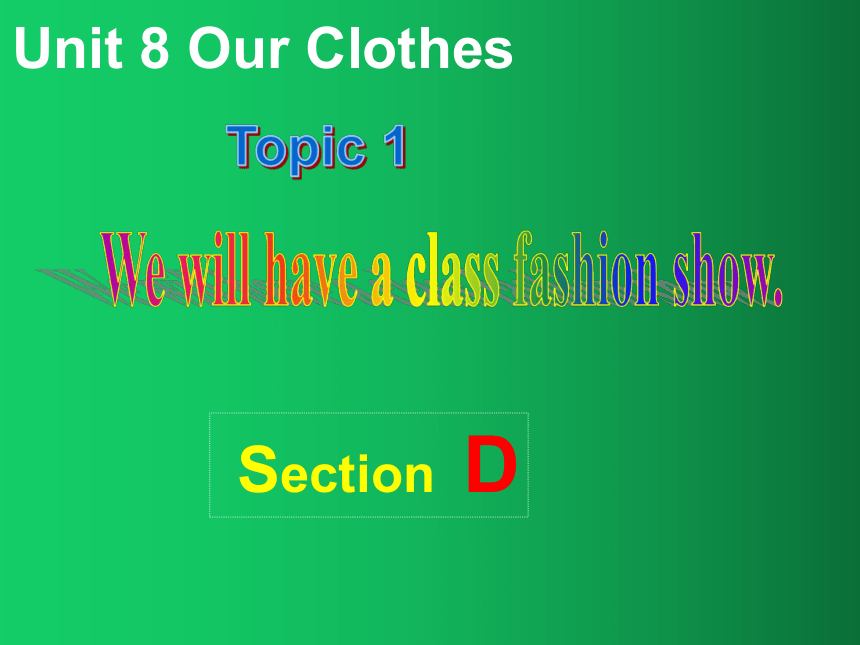
|
|
| 格式 | zip | ||
| 文件大小 | 2.7MB | ||
| 资源类型 | 教案 | ||
| 版本资源 | 仁爱科普版 | ||
| 科目 | 英语 | ||
| 更新时间 | 2020-05-01 23:14:12 | ||
图片预览


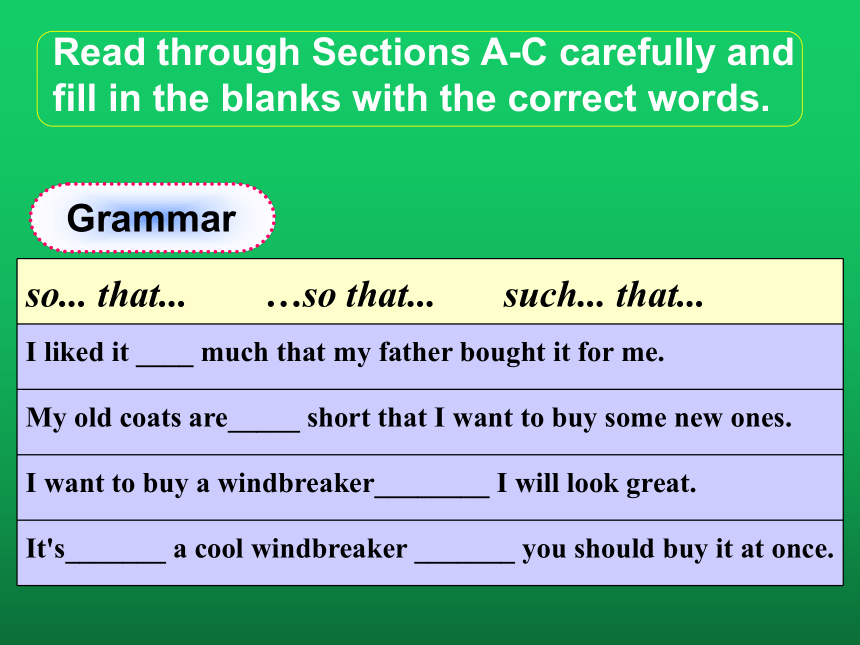
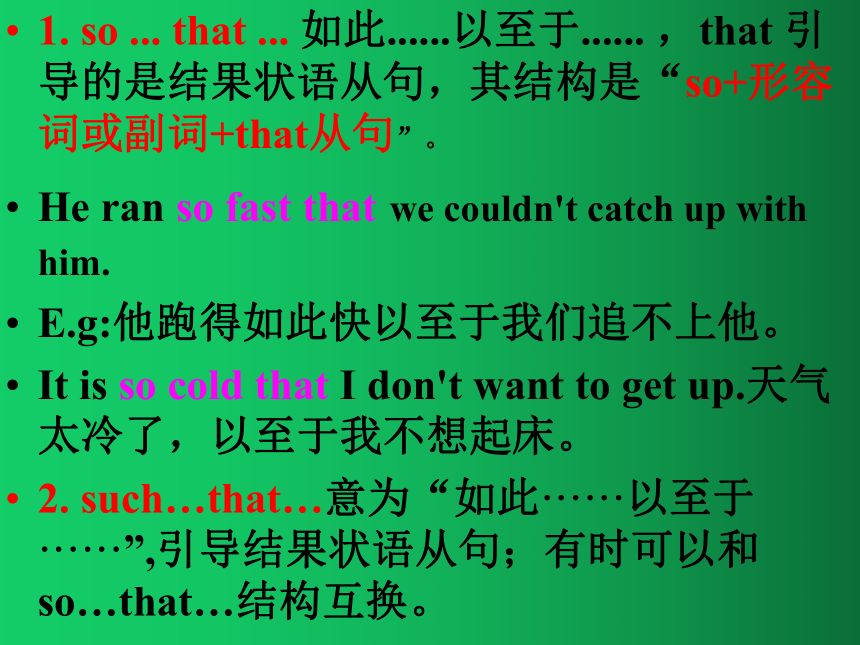
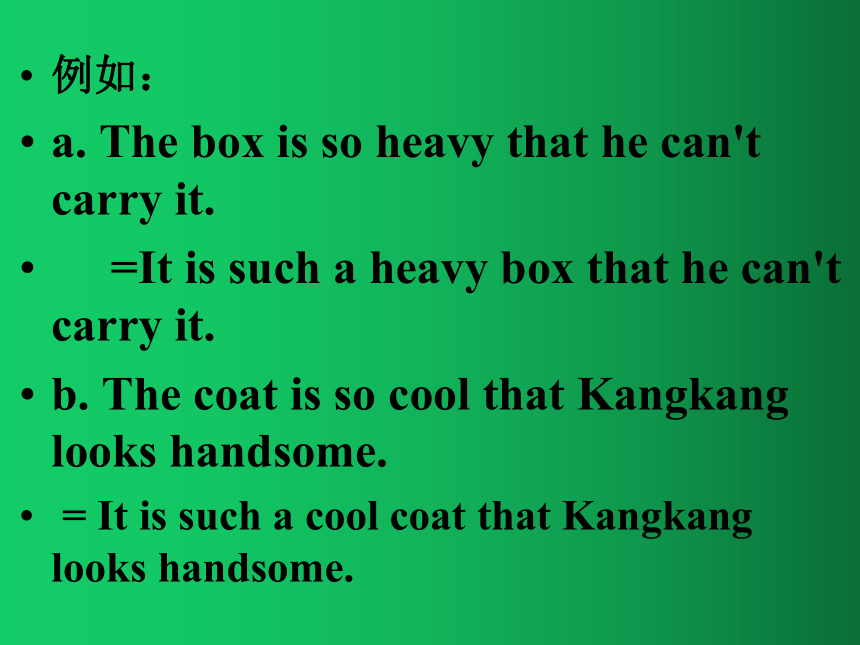
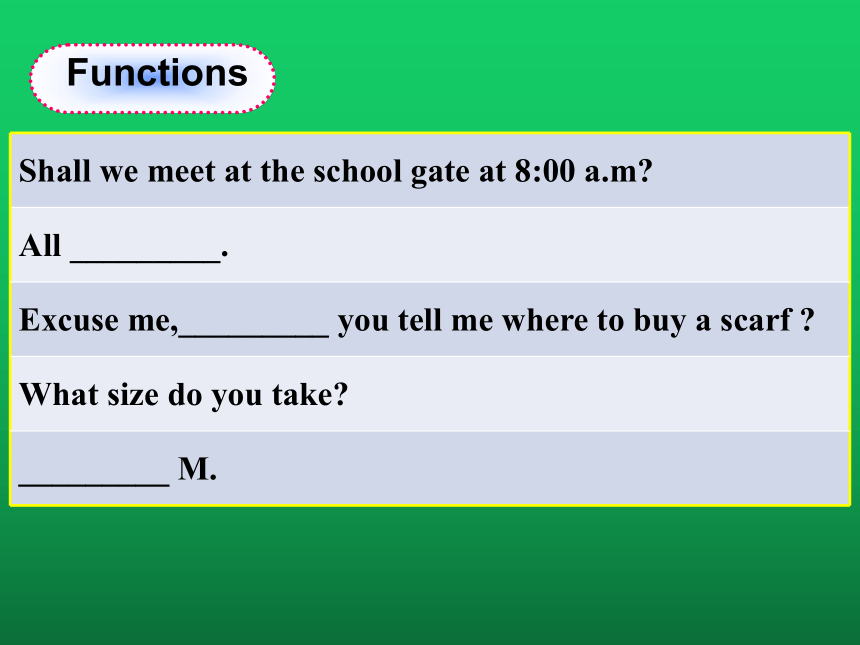
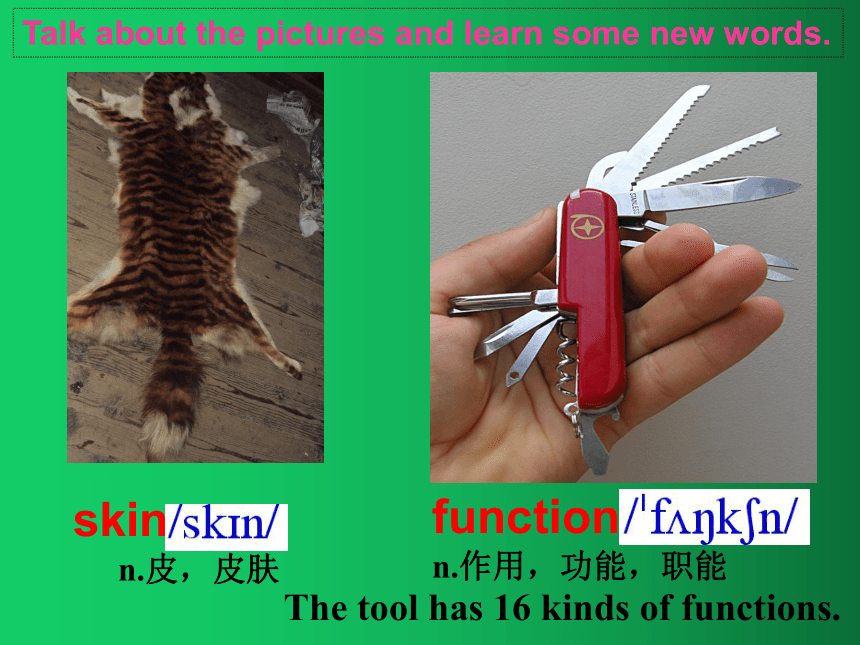

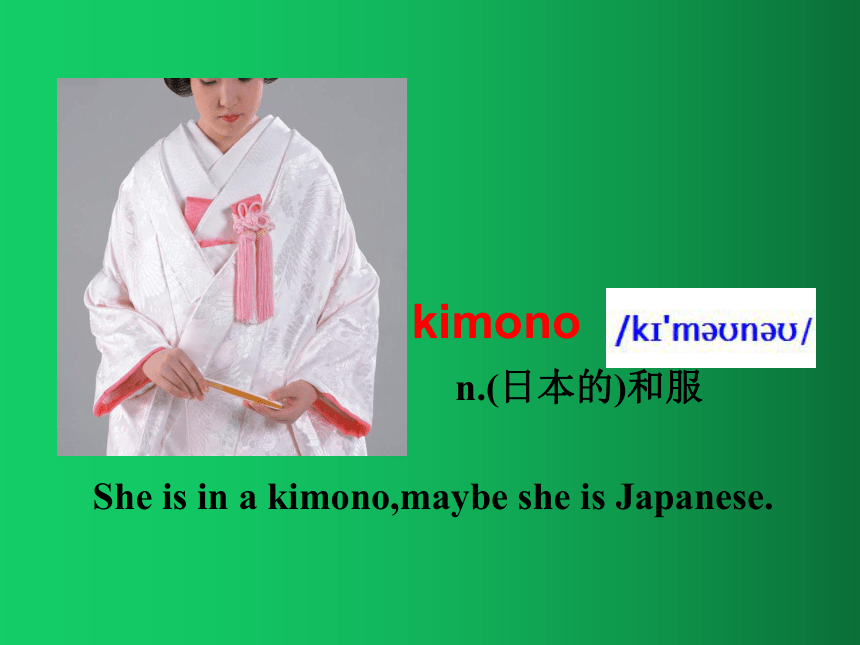
文档简介
课件27张PPT。Unit 8 Our Clothes We will have a class fashion show.Topic 1Section D学习目标:1. Learn some new words:
skin, material, uniform, kimono, sportswear, easy-going, saying, fun_ction, discuss, meaning
2. Learn some phrases:
be made of , be made from, protect... from
3. 复习本单元的语法内容。
Read through Sections A-C carefully and fill in the blanks with the correct words.Grammar1. so ... that ... 如此......以至于...... ,that 引导的是结果状语从句,其结构是“so+形容词或副词+that从句”。
He ran so fast that we couldn't catch up with him.
E.g:他跑得如此快以至于我们追不上他。
It is so cold that I don't want to get up.天气太冷了,以至于我不想起床。
2. such…that…意为“如此······以至于······”,引导结果状语从句;有时可以和so…that…结构互换。
例如:
a. The box is so heavy that he can't carry it.
=It is such a heavy box that he can't carry it.
b. The coat is so cool that Kangkang looks handsome.
= It is such a cool coat that Kangkang looks handsome.Functionsfunction
n.作用,功能,职能The tool has 16 kinds of functions.skin
n.皮,皮肤Talk about the pictures and learn some new words.uniform
n.制服The policemen are wearing uniforms. kimono
n.(日本的)和服 She is in a kimono,maybe she is Japanese.sportswear
n.运动服装 They like wearing sportswear,we may think they are active and like doing exercise. They like wearing yellow or pink clothes,maybe they are lively and easy-going.adj.随和的Look at the pictures and guess about the people based on what they wear. Then read and check your ideas. Read again and complete the following tasks.1.What does the passage mainly talk about?
A.The history of clothes. B.The functions of clothes.
C.The styles of clothes. D.The types of clothes.
2.Which of the following is true?
A.People wore the first types of clothes to show fashion.
B.Nowadays, clothes not only keep us warm.
C.Clothes can tell what your names are.
D.People almost wear the same kind of clothes now.
1b3.When we see a woman in a kimono,we might think she is _____.
4.If a man always wears sportswear,we may think he is _____.
5.If a person always wears yellow clothes,maybe he or she is ____.
6.Work in groups and discuss the meanings of the following sentences.
1)Clothes can also show people our jobs,our culture,our hobbies and even our moods.
2)You are what you wear.
Read and follow.Then try to retell the passage with the help of key words. The first types of clothes were made of animal skins. People started to wear clothes so that they could protect themselves from the sun, wind, rain and cold.
Today, we use different materials to make different kinds of clothes. But nowadays, clothes do more than just keep us warm. Clothing can also show people our jobs, our culture, our hobbies and even our moods. For example, when we see a man in a uniform, we can guess his job from the uniform. When we see a woman in a kimono, we may
think that she is Japanese. If a man always
wears sportswear, we may think he is active
and likes doing exercise. If a person always
wears yellow or pink clothes, maybe he or
she is lively and easy-going. We get ideas about
people from their clothes. As the saying goes,
“You are what you wear.”1. The first types of clothes were made of animal skins.
be made of... 由......制成(从表面可看出原材料)
be made from... 由......制成(从表面看不出原材料)
E.g:这张桌子是由木头制成的。
The desk is made of wood.
纸是由木材制成的。
Paper is made from wood.
The key points of 1a2. People started to wear clothes so that they could protect themselves from the sun, wind, rain and cold. 人们开始穿衣是为了免受日晒、风吹、雨淋和寒冷的侵袭。
(1)protect 意为“保护,防护”,其后可直接跟名词或代词。
E.g:We should learn to protect ourselves.我们应该学会保护自己。
(2)protect .... from ... 保护······不受······的危害
E.g:我会保护你不受周围一切的伤害。
I will protect you from everything around you.
3. But,nowadays, clothes do more than just keep us warm.
但是在当今,服装不仅仅是用来保暖的。
(1)more than 不只是
(2)keep +sb./sth.+adj.保持...
E.g:我们必须保持教室干净整洁。We must keep our classroom clean and tidy.
4. As the saying goes, “You are what you wear”.
正如俗语所讲:“衣如其人”。
The first___________ animal skins. People started ____ so that _____protect________from___________.
Today, we use____________to make ________________. But, nowadays, _______________. Clothing can also show________ and even _______. For example, ________in a uniform, we can ________. When____________in a kimono, we may think ______. If ___________sportswear, we may think _______. If ________yellow or pink clothes, maybe ________. We get ideas about people _______.As the saying goes, “____________.”Retell the passage with the help of key words.Describe the clothes you are wearing today. The following questions may help you.What are you wearing today?
What color/size ... are your clothes?
What materials are they made of?
What do you think of them? I’m wearing a white T-shirt today. The size is M. It is made of cotton. My jeans are blue. They are made of cotton, too. I like this kind of white sports shoes. They are made of leather and they are size 37. My clothes are very comfortable. They make me active.
Example:1.Survey your classmates about their favorite clothes and fill in the table.2.Discuss whether your classmates' dressing is suitable or not. Give your suggestions.
3.Write a report and present it to the class.Giving Suggestions on DressingProjectExercises in class Lisa is fourteen years old.She likes to wear different kinds of ___. One day she went___with her friends. They went into a new store. The clothes here are all made ___cotton. 根据短文内容填空。A pair of pants with two big pockets caught her eye. They looked very cool. But the pants were so expensive___ she couldn't afford them. She felt very disappointed.
When she got home,her mother told her that she ________some new clothes for her. She went into her own room and saw a pair of new ______ on the bed. In fact,the pants were the same style______the ones she saw in the store. She_______ them on and the pants fitted her well. She felt quite satisfied with them and said thanks _____her mom. _____happy she was !
1. Read and retell the text.
2. Review Topic 1 of Unit 8 and preview Section A of Topic 2.Homework
skin, material, uniform, kimono, sportswear, easy-going, saying, fun_ction, discuss, meaning
2. Learn some phrases:
be made of , be made from, protect... from
3. 复习本单元的语法内容。
Read through Sections A-C carefully and fill in the blanks with the correct words.Grammar1. so ... that ... 如此......以至于...... ,that 引导的是结果状语从句,其结构是“so+形容词或副词+that从句”。
He ran so fast that we couldn't catch up with him.
E.g:他跑得如此快以至于我们追不上他。
It is so cold that I don't want to get up.天气太冷了,以至于我不想起床。
2. such…that…意为“如此······以至于······”,引导结果状语从句;有时可以和so…that…结构互换。
例如:
a. The box is so heavy that he can't carry it.
=It is such a heavy box that he can't carry it.
b. The coat is so cool that Kangkang looks handsome.
= It is such a cool coat that Kangkang looks handsome.Functionsfunction
n.作用,功能,职能The tool has 16 kinds of functions.skin
n.皮,皮肤Talk about the pictures and learn some new words.uniform
n.制服The policemen are wearing uniforms. kimono
n.(日本的)和服 She is in a kimono,maybe she is Japanese.sportswear
n.运动服装 They like wearing sportswear,we may think they are active and like doing exercise. They like wearing yellow or pink clothes,maybe they are lively and easy-going.adj.随和的Look at the pictures and guess about the people based on what they wear. Then read and check your ideas. Read again and complete the following tasks.1.What does the passage mainly talk about?
A.The history of clothes. B.The functions of clothes.
C.The styles of clothes. D.The types of clothes.
2.Which of the following is true?
A.People wore the first types of clothes to show fashion.
B.Nowadays, clothes not only keep us warm.
C.Clothes can tell what your names are.
D.People almost wear the same kind of clothes now.
1b3.When we see a woman in a kimono,we might think she is _____.
4.If a man always wears sportswear,we may think he is _____.
5.If a person always wears yellow clothes,maybe he or she is ____.
6.Work in groups and discuss the meanings of the following sentences.
1)Clothes can also show people our jobs,our culture,our hobbies and even our moods.
2)You are what you wear.
Read and follow.Then try to retell the passage with the help of key words. The first types of clothes were made of animal skins. People started to wear clothes so that they could protect themselves from the sun, wind, rain and cold.
Today, we use different materials to make different kinds of clothes. But nowadays, clothes do more than just keep us warm. Clothing can also show people our jobs, our culture, our hobbies and even our moods. For example, when we see a man in a uniform, we can guess his job from the uniform. When we see a woman in a kimono, we may
think that she is Japanese. If a man always
wears sportswear, we may think he is active
and likes doing exercise. If a person always
wears yellow or pink clothes, maybe he or
she is lively and easy-going. We get ideas about
people from their clothes. As the saying goes,
“You are what you wear.”1. The first types of clothes were made of animal skins.
be made of... 由......制成(从表面可看出原材料)
be made from... 由......制成(从表面看不出原材料)
E.g:这张桌子是由木头制成的。
The desk is made of wood.
纸是由木材制成的。
Paper is made from wood.
The key points of 1a2. People started to wear clothes so that they could protect themselves from the sun, wind, rain and cold. 人们开始穿衣是为了免受日晒、风吹、雨淋和寒冷的侵袭。
(1)protect 意为“保护,防护”,其后可直接跟名词或代词。
E.g:We should learn to protect ourselves.我们应该学会保护自己。
(2)protect .... from ... 保护······不受······的危害
E.g:我会保护你不受周围一切的伤害。
I will protect you from everything around you.
3. But,nowadays, clothes do more than just keep us warm.
但是在当今,服装不仅仅是用来保暖的。
(1)more than 不只是
(2)keep +sb./sth.+adj.保持...
E.g:我们必须保持教室干净整洁。We must keep our classroom clean and tidy.
4. As the saying goes, “You are what you wear”.
正如俗语所讲:“衣如其人”。
The first___________ animal skins. People started ____ so that _____protect________from___________.
Today, we use____________to make ________________. But, nowadays, _______________. Clothing can also show________ and even _______. For example, ________in a uniform, we can ________. When____________in a kimono, we may think ______. If ___________sportswear, we may think _______. If ________yellow or pink clothes, maybe ________. We get ideas about people _______.As the saying goes, “____________.”Retell the passage with the help of key words.Describe the clothes you are wearing today. The following questions may help you.What are you wearing today?
What color/size ... are your clothes?
What materials are they made of?
What do you think of them? I’m wearing a white T-shirt today. The size is M. It is made of cotton. My jeans are blue. They are made of cotton, too. I like this kind of white sports shoes. They are made of leather and they are size 37. My clothes are very comfortable. They make me active.
Example:1.Survey your classmates about their favorite clothes and fill in the table.2.Discuss whether your classmates' dressing is suitable or not. Give your suggestions.
3.Write a report and present it to the class.Giving Suggestions on DressingProjectExercises in class Lisa is fourteen years old.She likes to wear different kinds of ___. One day she went___with her friends. They went into a new store. The clothes here are all made ___cotton. 根据短文内容填空。A pair of pants with two big pockets caught her eye. They looked very cool. But the pants were so expensive___ she couldn't afford them. She felt very disappointed.
When she got home,her mother told her that she ________some new clothes for her. She went into her own room and saw a pair of new ______ on the bed. In fact,the pants were the same style______the ones she saw in the store. She_______ them on and the pants fitted her well. She felt quite satisfied with them and said thanks _____her mom. _____happy she was !
1. Read and retell the text.
2. Review Topic 1 of Unit 8 and preview Section A of Topic 2.Homework
同课章节目录
- Unit 5 Feeling excited
- Topic 1 You look excited
- Topic 2 I’m feeling better now.
- Topic 3 Many things can affect our feelings.
- Unit 6 Enjoying Cycling
- Topic 1 We're going on a three-day visit to Mount
- Topic 2 How about exploring Tian’anmen Square?
- Topic 3 Bicycle riding is good exercise.
- Unit 7 Food festival
- Topic 1 We’re preparing for a food festival.
- Topic 2 I’m not sure whether I can cook it well.
- Topic 3 I Cooked the Most Successfully
- Unit 8 Our Clothes
- Topic 1 We will have a class fashion show.
- Topic 2 We can design our own uniforms.
- Topic 3 He said the fashion show was wonderful.
